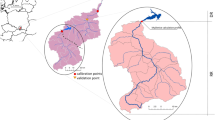Abstract
Monte Carlo simulation (MCS) methodology has been applied to explain the variability of parameters for pollutant transport and fate modeling. In this study, the MCS method was used to evaluate the transport and fate of copper in the sediment of the Tibagi River sub-basin tributaries, Southern Brazil. The statistical distribution of the variables was described by a dataset obtained for copper concentration using sequential extraction, organic matter (OM) amount, and pH. The proposed stochastic spatial model for the copper transport in the river sediment was discussed and implemented by the MCS technique using the MatLab 7.3™ mathematical software tool. In order to test some hypotheses, the sediment and the water column in the river ecosystem were considered as compartments. The proposed stochastic spatial model makes it possible to predict copper mobility and associated risks as a function of the organic matter input into aquatic systems. The metal mobility can increase with the OM posing a rising environmental risk.













Similar content being viewed by others
References
Allard T, Menguy N, Salomon J, Calligaro T, Weber T, Calas G, Benedetti M (2004) Revealing forms of iron in river-borne material from major tropical rivers of the Amazon Basin (Brazil). Geochim Cosmochim Acta 68(14):3079–3094
Bansidhar SG, Karimi IA, Ray MB (2001) Modeling and Monte Carlo simulation of TCDD transport in a river. Water Res 35(5):1263–1279
Dudley RM (2002) Real analysis and probability, 2nd edn. Cambridge University Press, Cambridge
Eggleton J, Thomas KV (2004) A review of factors affecting the release and biovailability of contaminants during sediment disturbance events. Environ Int 30:973–980
Giri BS, Karimi IA, Ray MB (2001) Modeling and monte carlo simulation of tcdd transport in a river. Water Res 35(5):1263–1279
He M, Wang Z, Tang H (2001) Modeling the ecological impact of heavy metals on aquatic ecosystems: a framework for the development of an ecological model. Sci Total Environ 266:291–298
Jang C, Lin K, Liu C, Lin M (2009) Risk-based assessment of arsenic-affected aquacultural water in blackfoot disease hyperendemic areas. Stoch Environ Res Risk Assess 23:603–612
Lindenschmidt KE (2006) Testing for the transferability of a water quality model to areas of similar spatial and temporal scale based on an uncertainty vs. complexity hypothesis. Ecol Complex 3:241–252
Lindenschmidt K, Fleischbein K, Baborowskib M (2007) Structural uncertainty in a river water quality modelling system. Ecol Model 204:298–300
Liu WC, Chang SW, Jiann KT, Wen LS, Liu KK (2007) Modelling diagnosis of heavy metal (copper) transport in an estuary. Sci Total Environ 388:234–249
Lu Y, Allen HE (2002) Characterization of copper complexation with natural dissolved organic matter (DOM)—link to acidic moieties of DOM and competition by Ca and Mg. Water Res 36:5083–5101
Lu Y, Allen HE (2006) A predictive model for copper partitioning to suspended particulate matter in river waters. Environ Pollut 143:60–72
Massoudieh A, Bombardelli F, Ginn T (2010) A biogeochemical model of contaminant fate and transport in river waters and sediments. J Contam Hyd 112:103–117
Mccutcheon C (1989) Water quality modeling—transport and surface exchange in rivers, vol 1. CRC Press, Boca Raton
Osidele OO, Zeng W, Beck MB (2003) Coping with uncertainty: a case study in sediment transport and nutrient load analysis. J Water Resour Plan Manage 129(4):345–355
Paleologos E, Sarris T (2011) Stochastic analysis of flux and head moments in a heterogeneous aquifer system. Stoch Environ Res Risk Assess 25:747–759
Radovanovic H, Koelmans AA (1998) Prediction of in situ trace metal distribution coefficients for suspended solids in natural waters. Environ Sci Technol 32:753–759
Ramirez M, Massolo S, Frache R, Correa JA (2005) Metal speciation and environmental impact on sandy beaches due to El Salvador copper mine, Chile. Mar Pollut Bull 50:62–72
Sahoo G, Schladow S, Reuter J, Coats R (2011) Effects of climate change on thermal properties of lakes and reservoirs, and possible implications. Stoch Environ Res Risk Assess 25:445–456
Silva I, Abate G, Lichtig J, Masini J (2002) Heavy metal distribution in recent sediments of the Tietê–Pinheiros river system in São Paulo state, Brazil. Appl Geochem 17:105–116
Singh KP, Mohan D, Singh VK, Malik A (2005) Studies on distribution and fractionation of heavy metals in Gomti river sediments—a tributary of the Ganges, India. J Hydrol 312:14–27
Tessier A, Campbell PGC, Bisson M (1979) Sequential extraction procedure for the speciation of particulate trace metals. Anal Chem 51(7):844–851
Tessier A, Carignan R, Dubreur B, Rafin B (1989) Partitioning of zinc between the water column and the oxic sediments in lakes. Geochim Cosmochim Acta 53(7):1511–1522
Thomas R, Ure A, Davidson C, Littlejohn D, Rauret G, Rubio R, López-Sánchez J (1994) Three-stage sequential extraction procedure for the determination of metals in river sediments. Anal Chim Acta 286:423–429
Vuksanovic V, Smedt FD, Meerbeeck SV (1996) Transport of polychlorinated biphenyls (PCB) in the Scheldt Estuary simulated with the water quality model WASP. J Hydrol 174:1–18
Wallach D, Genard M (1998) Effect of uncertainty in input and parameter values on model prediction error. Ecol Model 105:337–345
Wang XL, Tao S, Dawson RW, Wang XJ (2004) Uncertainty analysis of parameters for modeling the transfer and fate of benzo(a)pyrene in Tianjin wastewater irrigated areas. Chemosphere 55:525–531
Zhang Y, Xia J, Shao Q, Zhai X (2011) Water quantity and quality simulation by improved SWAT in highly regulated Huai River Basin of China. Stoch Environ Res Risk Assess (12). doi:10.1007/s00477-011-0546-9
Acknowledgments
This work was partially funded by the Brazilian agency The National Council for Scientific Technological Development (CNPq) under Research Grant Contract #303426/2009-8 and scholarship. The authors would like to express gratitude to the Associate Editor and anonymous reviewers for their invaluably constructive suggestions and helpful comments, which have enhanced the readability and quality of the manuscript. Finally, authors would like to thank Evgeny Galunin for providing language help.
Author information
Authors and Affiliations
Corresponding author
Rights and permissions
About this article
Cite this article
Corazza, M.Z., Abrão, T., Lepri, F.G. et al. Monte Carlo method applied to modeling copper transport in river sediments. Stoch Environ Res Risk Assess 26, 1063–1079 (2012). https://doi.org/10.1007/s00477-012-0564-2
Published:
Issue Date:
DOI: https://doi.org/10.1007/s00477-012-0564-2




